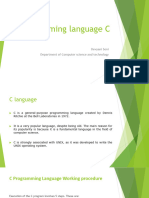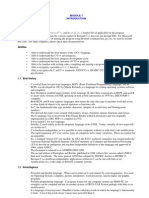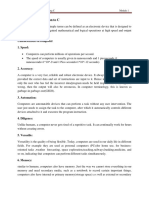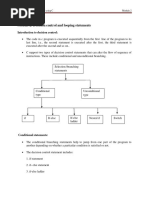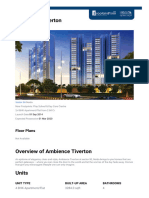Concepts of C Programming_01
Uploaded by
DeepikaConcepts of C Programming_01
Uploaded by
DeepikaProblem Solving and Programming with C GITAM
Introduction to C Language
Introduction to C
C is a general-purpose programming language developed by Dennis Ritchie at A T & T Bell
laboratories in 1972.
C is closely related to UNIX system and many of the important ideas are taken from “BCPL”
(Basic Combined Programming Language) developed by Martin Richards and “B” language.
C provides variety of data types, derived data types like pointers, arrays, structures and unions.
It also provides control flow constructions like conditional and looping constructs etc..,
Why C?
Generally, computer understands only binary data i.e., 0’s and 1’s.
Writing and understanding programs in binary was very difficult and time consuming.
To overcome this middle level language was introduced; the user feels comfortable in writing the
program.
Many middle levels languages are available like C, C++ etc.
Even though the program is written in middle level language, the code has to be converted to
machine language so that computer can execute it for which we make use of compiler.
Advantages/Features of C Language
There are many features which attracted programmers for the usage of C. They are
1. Simple and Portable: it gives programmer access to all functions of the machine and can work
on different kinds of computers.
2. Powerful and Flexible: most of the functionalities like UNIX is written in C. The compiler
and interpreter are also written in C language.
3. Modularity: C is a structured programming language which mainly deals with the procedures.
It is also termed as procedure-oriented language.
4. Efficient: C is more efficient which increases the speed of execution and management of
memory compared to low level languages.
5. Programmer oriented: It has many data types and flexible control structure which gives
access to hardware.
6. Other features include
❖ Machine independent
❖ No need to worry about machine details.
1 Department of Computer Science and Engineering, GST
Problem Solving and Programming with C GITAM
Characteristics of C:
C is a middle level language.
C is a structured language.
C is a programmer’s language.
C is a case sensitive language.
Versions of C:
The main is ANSI C (accepted by American National Standards Institute) under which we have
✓ Lattice C ✓ Turbo C ✓ Tiny C
✓ Microsoft C ✓ Borland C ✓ Online Compilers
✓ Quick C ✓ Small C
Developing Programs in C:
1. Creating the Program:
The source program can be written or modified using editor and can be saved with
the extension of .C
2. Compiling the program.
Where the program is checked for the Syntax and Semantics of the language and
reports the errors to the user. These errors have to be corrected by the users in the source
program.
3. Executing the Program.
Once the error free code is generated after the compilation process, the program can
be executed with valid inputs by linking to the required header files.
For the successful execution of the C Program some of the software components are required
they are:
❖ Operating System. ❖ Assembler.
❖ Text Editors. ❖ Loader.
❖ Compilers. ❖ Linker.
On the successful execution of the C Program the following files are created:
1. Pgm.C: Contains source code of the program saved in .C extension.
2. Pgm.txt: Contains text format of the source code stored in .txt a notepad file.
3. Pgm.obj: Contains the object code of source program in terms of 0’s & 1’s.
4. Pgm.exe: An Executable file generated after successful compilation.
5. Pgm.bak: An backup file for the Pgm.C
2 Department of Computer Science and Engineering, GST
Problem Solving and Programming with C GITAM
Typical steps for Entering, Compiling and Executing C programs
Editor/IDE
C Source Code
Preprocessor
Preprocessed Code
Compiler
Assembly Code
Libraries and
other object
Assembler
modules
Object Code
Linker / Link Editor
Executable Code
Such as Hard disk as an
Secondary Storage Executable image.
When running
Loader /execute the program
Error and Its Type
Error is also known as bug in the world of programming, it may occur unwillingly which may prevent
the program to compile and run correctly as per the expectation of the programmer. Programmer may
come across with the following types of errors.,
Syntax Error: errors due to the fact that the syntax of the language is not respected.
Example: int a=20 // Error: Statement missing (;)
Semantic Error: errors due to the improper use of program statements.
Example 1.int i; // Error: Static semantic error @ compile time.
i++; // Error: Variable “i” is not initialized.
Example 2.int a[10]; // Error: Dynamic semantic error @ run time.
a[10]=40; // Error: Invalid Initialization of 11 position with
value 40.
3 Department of Computer Science and Engineering, GST
Problem Solving and Programming with C GITAM
Logical Error: errors due to the fact that the specification is not respected.
Example: // Program for addition of two numbers.
int a=20, b=10, c;
c=a-b;
// Error: in logic subtraction is done instead of addition.
At the time of error detection, it is classified in to two types:
Compile Time Errors: Syntax and Static Semantic errors indicated by the compiler.
Runtime Errors: Dynamic semantic errors and logical errors that cannot be detected by the
compiler.
Note:
Debugging: The process of identifying the errors and correcting it.
Source Code: The text of a program that a user can read, modify and given as a input for the C
compiler.
Object Code: Translated code generated by the compiler by taking source code as the input and
computer can executes it directly.
Compile Time: The time during which your program is being compiled.
Run Time: The time during which your program is executing.
Short Cut keys (Turbo C++ IDE):
▪ Menu: F10.
▪ Saving: Alt + F2.
▪ Opening the Existed program: F3.
▪ Compilation: F9.
▪ Execution: Ctrl + F9.
▪ To see the previously Executed screen: Alt + F5.
▪ Single Tab View: F5.
▪ To Maximize the Screen: Alt + Enter.
4 Department of Computer Science and Engineering, GST
Problem Solving and Programming with C GITAM
Concepts of C Programming
Structure of C Program
Comments/Documentation Section
Preprocessor Directives
Global Declaration Section
void main() [Program Header]
{
Local Declaration part
Execution part
Statement 1
------------
------------
Statement n
}
User Defined Functions
Comments/Documentation Section
Describes the program, which helps in understanding the program easily.
The comments are not mandatory.
The comment are may be of:
✓ Single line Comment:
❖ Description is written in single line with the delimiter //.
❖ Example: //Program to multiply two numbers.
✓ Multi line Comment:
❖ It is written in more than one line.
❖ Begins with /* and ends with */. The symbols /* and */ are called comment line
delimiters
❖ Example:
/*Program to find the roots of the Quadratic equation on checking for value of a not
equal to 0 and condition for roots are real and equal, real and distinct & Imaginary*/
Note: Comments are ignored by C compiler, i.e., everything within comment delimiters
5 Department of Computer Science and Engineering, GST
Problem Solving and Programming with C GITAM
Preprocessor Directives
Preprocessor Directives begins with a # symbol.
It preprocesses the include files, conditional compilation instructions and macros before it
encounters the main () function.
A function is a building block of a program where it performs a particular task, on execution it
should return some type of value to where it is called.
Some examples of preprocessor statements are:
#include <stdio.h>
#include <conio.h>
#include <string.h>
#include <math.h>
#define PI 3.142 Etc…
Global Declaration Section
There will be some variable which has to be used throughout / anywhere in program i.e.., the
scope of the variable is in more than one function can be declared in global Declaration Section.
The Program Header
Every program must contain a main() function. The execution always starts from main function.
Every C program must have only one main function.
void is the return type mentioned with main( ) , which represents main( ) returning nothing.
Body of the program
Series of statements that performs specific task will be enclosed within braces { and }
It is present immediately after program header.
It consists of two parts
1. Local Declaration part: Describes variables used in the program
Ex: int sum = 0;
int a , b:
float b;
2. Executable part: Contains input statements, processing statements (logic) & output
statements to carry out some particular task.
Note: All statements should end with semicolon(; ) a statement terminator.
User Define Function / Subroutine Section:
All user defined functions that are called in main function should be defined.
6 Department of Computer Science and Engineering, GST
Problem Solving and Programming with C GITAM
C Programming Concepts
A program is a group of instructions given by the programmer to perform a specific task.
To achieve programming there are many basic components of programming that has to be learnt.
Character set of C language
The C language includes the characters.
Alphabets(lowercase a-z, Uppercase A-Z)
Digits (0-9)
Special Symbols( ~ ‘ ! @ # % & * () - + / $ = \ { } [ ] : ; “ “ ? etc)
C- Tokens
Tokens are the smallest individual units of C program.
A token is collection of characters.
Some of the C- Tokens available in C are:
C Tokens
String Special
Key Words Idenfifiers Constants Operators
Constants Symbols
Integer Real
Constants Constants
Keywords
Words which have predefined / fixed meanings are called keywords.
These are basic building blocks of C program statements.
The meaning of keywords will be known to computer no new name or meaning can be defined
for it.
There are totally 32 keywords supported in C they are:
auto double if static
break else int struct
case enum long switch
char extern near typedef
const float register union
continue for return unsigned
default while short void
do goto signed while
Important points to be remembered about keywords
7 Department of Computer Science and Engineering, GST
Problem Solving and Programming with C GITAM
Keywords should be written in lowercase letters.
Keywords meaning cannot be changed by the users.
It should not be used as variables, functions names and array names.
Identifiers ( Variables )
Identifiers are the name given to the program element.
The program element may be identified as variables, functions and arrays etc..,
These are user defined names and do not have fixed meaning.
It is name given to computer memory location.
Variables – Variables are the identifiers, the named memory location whose value changes on
program execution.
Rules for identifiers/variables
First character must be an alphabet or an underscore(_)
First character is followed by any number of letters or digits.
Only first 31 characters are significant
Keywords cannot be used as identifier / variable.
Must not contain blank space/white space
Must contain only alphabets, digits and one special symbol underscore ( _ )
Ex:-
india Valid
india06 Valid
_india Valid
india_06 Valid
india_06_king Valid
_ _india not valid as it contains successive underscore
06india not valid as it starts from digits
Int not valid since int is a keyword
india 06 not valid since there is space between india and 06
india@06 not valid since @ is not allowed
8 Department of Computer Science and Engineering, GST
Problem Solving and Programming with C GITAM
Data types
The data type defines the type of data stored in memory location or the type of data the variable
can hold.
Data Types classification:
Data Types
Primary Data Types Secondary Data Types
Character Array
Integer Pointer
Float Structure
Double Union
Void Enum etc..,
Primary data types – are the fundamental data types which are readily available in C.
Secondary data types – are the derived types with the help of primary data types.
Character data type (char):
Capable of holding one character from the local character set.
The size of the character variable is 1 byte.
The range is from -128 to +127.
Each character stored in the memory is associated with a unique value termed as ASCII
(American Standard Code for Information Interchange).
It is used to represent character and strings.
Integer data type (int):
It stores an integer value or integer constant.
Typically reflects the natural size of integers on host machine.
General size is 2 bytes.
The range is -32768 to +32767 ( To calculate the size 1 byte =8bits so 2bytes will be 16 bits
then range will be -215 to +215 -1).
int can have additional data type which is long int whose size will be of 4 bytes and the size
ranging from -231 to +231 -1.
9 Department of Computer Science and Engineering, GST
Problem Solving and Programming with C GITAM
Floating data type (float):
Single precision floating point.
Holds a real constant.
The size is 4 bytes.
The range is -3.4e38 to +3.4e38.
Float can hold the real constant accuracy up to 6 digits after the decimal point. That is 23.456789
is valid where as 45.678953231 is invalid.
Double data type (double):
Double precision point.
Holds real constant.
The size is 8 bytes.
The range is from -1.7e308 to +1.7 e308.
Double can hold real constant accuracy up to 16 digits after the decimal point.
Void data type (void):
It is an empty data type.
No memory is allocated.Mainly used when there are no return values on function execution.
Table Contains All Data Types Defined by the C Standard
Sizes in
Sl. No Data Type Range
Bits Bytes
1 char 8 1 -128 to 127
2 unsigned char 8 1 0 to 255
3 signed char 8 1 -128 to 127
4 int 16 2 -32,768 to 32,767
5 unsigned int 16 2 0 to 65,535
6 signed int 16 2 -32,768 to 32,767
7 short int 16 2 -32,768 to 32,767
8 unsigned short int 16 2 0 to 65,535
9 signed short int 16 2 -32,768 to 32,767
10 long int 32 4 -2,147,483,648 to 2,147,483,647
11 long longint 64 8 -(263 -1) to (263 -1) (Added by C99)
12 signed long int 32 4 -2,147,483,648 to 2,147,483,647
13 unsigned long int 32 4 0 to 4,294,967,295
14 unsigned long longint 64 8 264 – 1 (Added by C99)
15 float 32 4 -3.4E38 to +3.4E38 with six digits of precision
16 double 64 8 1.7e308 to +1.7 e308 with ten digits of precision
10 Department of Computer Science and Engineering, GST
Problem Solving and Programming with C GITAM
Format Specifiers
Format specifiers are the character string with % sign followed with a character. It specifies the
type of data that is being processed. It is also called conversion specifier. When data is being
output or input it must be specified with identifier (variable) and their format specifier.
There are many format specifiers defined in C. Take a look at the following list:
Symbols Meaning
%i or %d integer number
%f float point number
%c Character
%o octal number
%x hexadecimal integer(Lower case letter x)
%X hexadecimal integer(Upper case letter X)
%e floating point value with exponent(Lower case letter e)
%E floating point value with exponent (Upper case letter E)
%g floating point value with or without exponent
%ld long integer
%s String
%lf double
Escape sequence:
Escape sequence are special character denoted by a backslash (\) and a character after it. It is
called escape sequence because it causes an ‘escape’ from the normal way for characters are
interpreted. For example if we use ‘\ n’, then the character is not treated as n but it is treated as
a new line. Some of the common escape sequence characters are:
Escape sequence Meaning
\a Bell
\ Beep
\n new line
\t tab horizontal
\b move the character to left one space
\\ Backslash
\’ single quote
\” double quote
11 Department of Computer Science and Engineering, GST
You might also like
- C Programming For Beginners: The Simple Guide to Learning C Programming Language Fast!From EverandC Programming For Beginners: The Simple Guide to Learning C Programming Language Fast!5/5 (1)
- Landmasses and Bodies of Water Surrounding The Philippines100% (2)Landmasses and Bodies of Water Surrounding The Philippines18 pages
- ES084 - Lecture Notes MADE4 Learning Part 1 - ANo ratings yetES084 - Lecture Notes MADE4 Learning Part 1 - A125 pages
- C Programming Class Notes Unit-1 (Part-1)No ratings yetC Programming Class Notes Unit-1 (Part-1)5 pages
- Chapter 5 - Introduction To C Programming Language100% (1)Chapter 5 - Introduction To C Programming Language8 pages
- Ch # 08 + Ch # 11 + Ch # 12 + Ch # 13+ Ch # 14No ratings yetCh # 08 + Ch # 11 + Ch # 12 + Ch # 13+ Ch # 1421 pages
- Lab 1 Introduction Basic C Language and Turbo C Compiler: ObjectiveNo ratings yetLab 1 Introduction Basic C Language and Turbo C Compiler: Objective6 pages
- History of C Programming Language: Laboratories" of USA in 1972No ratings yetHistory of C Programming Language: Laboratories" of USA in 197212 pages
- Ch01-Introduction-To-Cprogramming LanguageNo ratings yetCh01-Introduction-To-Cprogramming Language31 pages
- Porcedraul Programming Unit-1B_Intro to C ProgrammingNo ratings yetPorcedraul Programming Unit-1B_Intro to C Programming31 pages
- C Programming Wizardry: From Zero to Hero in 10 Days: Programming Prodigy: From Novice to Virtuoso in 10 DaysFrom EverandC Programming Wizardry: From Zero to Hero in 10 Days: Programming Prodigy: From Novice to Virtuoso in 10 DaysNo ratings yet
- 2.2.1 process improve quality of teaching and learningNo ratings yet2.2.1 process improve quality of teaching and learning2 pages
- Visvesvaraya Technological University, Belagavi: VTU-ETR Seat No.: ANo ratings yetVisvesvaraya Technological University, Belagavi: VTU-ETR Seat No.: A48 pages
- Module 5 Structure, Union and Enumerated Data Type100% (2)Module 5 Structure, Union and Enumerated Data Type17 pages
- Q1 2023 MAIN Investor Presentation 28th April 2023 Final VersionNo ratings yetQ1 2023 MAIN Investor Presentation 28th April 2023 Final Version35 pages
- Soc105 - r5 - Consumption and Mass Media Worksheet100% (1)Soc105 - r5 - Consumption and Mass Media Worksheet3 pages
- Excel Engineering College, Komarapalayam: Department of Ece Class Room Furniture Arrangement DetailsNo ratings yetExcel Engineering College, Komarapalayam: Department of Ece Class Room Furniture Arrangement Details4 pages
- Lecture 3 - Variables Constants and Data TypesNo ratings yetLecture 3 - Variables Constants and Data Types34 pages
- Numerical Investigation of Near-Muzzle Blast Levels For Perforated Muzzle Brake Using High Performance ComputingNo ratings yetNumerical Investigation of Near-Muzzle Blast Levels For Perforated Muzzle Brake Using High Performance Computing9 pages
- The Clay Research Group The Clay Research GroupNo ratings yetThe Clay Research Group The Clay Research Group9 pages
- Soalan Matematik Tambahan Kertas 1 SABAHNo ratings yetSoalan Matematik Tambahan Kertas 1 SABAH18 pages
- [FREE PDF sample] Parsforte Internazionale de arte 3rd Edition Parsforte International Amiramin Sharifi ebooks100% (3)[FREE PDF sample] Parsforte Internazionale de arte 3rd Edition Parsforte International Amiramin Sharifi ebooks50 pages
- CLC 12 - Capstone Draft Proposal WorksheetNo ratings yetCLC 12 - Capstone Draft Proposal Worksheet2 pages
- Engineering Economics - Law of Demand - Prof. Yashvantsinh YadavNo ratings yetEngineering Economics - Law of Demand - Prof. Yashvantsinh Yadav14 pages
- C Programming For Beginners: The Simple Guide to Learning C Programming Language Fast!From EverandC Programming For Beginners: The Simple Guide to Learning C Programming Language Fast!
- Landmasses and Bodies of Water Surrounding The PhilippinesLandmasses and Bodies of Water Surrounding The Philippines
- Chapter 5 - Introduction To C Programming LanguageChapter 5 - Introduction To C Programming Language
- Lab 1 Introduction Basic C Language and Turbo C Compiler: ObjectiveLab 1 Introduction Basic C Language and Turbo C Compiler: Objective
- History of C Programming Language: Laboratories" of USA in 1972History of C Programming Language: Laboratories" of USA in 1972
- Porcedraul Programming Unit-1B_Intro to C ProgrammingPorcedraul Programming Unit-1B_Intro to C Programming
- C Programming Wizardry: From Zero to Hero in 10 Days: Programming Prodigy: From Novice to Virtuoso in 10 DaysFrom EverandC Programming Wizardry: From Zero to Hero in 10 Days: Programming Prodigy: From Novice to Virtuoso in 10 Days
- 2.2.1 process improve quality of teaching and learning2.2.1 process improve quality of teaching and learning
- Visvesvaraya Technological University, Belagavi: VTU-ETR Seat No.: AVisvesvaraya Technological University, Belagavi: VTU-ETR Seat No.: A
- Module 5 Structure, Union and Enumerated Data TypeModule 5 Structure, Union and Enumerated Data Type
- Q1 2023 MAIN Investor Presentation 28th April 2023 Final VersionQ1 2023 MAIN Investor Presentation 28th April 2023 Final Version
- Soc105 - r5 - Consumption and Mass Media WorksheetSoc105 - r5 - Consumption and Mass Media Worksheet
- Excel Engineering College, Komarapalayam: Department of Ece Class Room Furniture Arrangement DetailsExcel Engineering College, Komarapalayam: Department of Ece Class Room Furniture Arrangement Details
- Numerical Investigation of Near-Muzzle Blast Levels For Perforated Muzzle Brake Using High Performance ComputingNumerical Investigation of Near-Muzzle Blast Levels For Perforated Muzzle Brake Using High Performance Computing
- [FREE PDF sample] Parsforte Internazionale de arte 3rd Edition Parsforte International Amiramin Sharifi ebooks[FREE PDF sample] Parsforte Internazionale de arte 3rd Edition Parsforte International Amiramin Sharifi ebooks
- Engineering Economics - Law of Demand - Prof. Yashvantsinh YadavEngineering Economics - Law of Demand - Prof. Yashvantsinh Yadav















